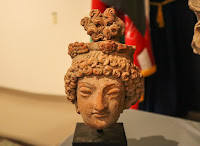 Cambodia,Hindman Auctions,Khmer,Subhash Kapoor
Cambodia,Hindman Auctions,Khmer,Subhash Kapoor
 No comments
No comments
Justice for Cambodia: Manhattan D.A. Repatriates Looted Artifacts
This week the Manhattan District Attorney’s Office announced the restitution of two two looted Cambodian sculptures, recovered as part of its ongoing investigation into global antiquities trafficking networks, including that of Subhash Kapoor, who is currently awaiting extradition from India to face charges in New York.
A former Manhattan ancient art dealer who operated the gallery Art of the Past, Kapoor is at the center of one of the largest antiquities trafficking networks in history, orchestrating the looting and illegal sale of thousands of cultural artefacts from India, Cambodia, and other Southeast Asian countries.
Operating under the guise of a legitimate antiquities dealer, Kapoor used his once-prestigious New York gallery to launder stolen artefacts many of which found their way into major museums and private collections worldwide. In India, he worked with temple looters and smugglers to steal sacred Hindu and Buddhist sculptures, many of which were violently removed from their original sites. Similarly, in Cambodia, Kapoor’s network targeted Khmer-era temples, plundering centuries-old statues and carvings that were then smuggled out of the country using falsified provenance documents.
Arrested in Germany on 30 October 2011 while on business to Cologne, he was extradited to India, where he remains in custody for his role in illicit activities tied to that source country, with U.S. authorities seek his extradition to face additional charges in New York. To date, investigations into his network have led to the recovery and repatriation of hundreds of looted artefacts, and has exposed the weaknesses in the ancient art market which were easily exploited.
Cultural Significance of the Returned Artefacts
The first artefact, a Baphuon Period, (11th Century CE) Sandstone Torso, carved standing in samabhanga and wearing a high-waisted sampot, was excavated from the site of the ancient temple Prasat Bavel in northwestern Cambodia and was displayed at the Wat Po Veal Museum in 1965. The statue is one of at least 68 statues dating from the 6th century to the post-Angkorian period that were stolen from Battambang Provincial Museum or the Wat Po Veal Museum in Battambang City during Cambodia's unrest and was stolen after being placed in protective storage by national authorities. |
| The Khmer artifact collection at the Wat Po Veal Museum was greatly damaged (with some artefacts looted) in the 1970s, as this early 1980s photo demonstrates. - Image Credit:CDCAM |
The torso began circulating on the ancient art market in 1981 at Spink & Son, Ltd., a defunct London auction house that has frequently been linked to looted antiquities. There it was acquired by a Chicago collector on 20 January 1982. Once in the US, it remained in private hands for decades until it was placed up for sale by Freeman’s | Hindman auction in New York on 20 September 2024 as Lot 153, at which point the DANY-ATU swiftly intervened and seized the artefact.
The second artefact, a 12th-century Angkor-style Khmer Head of a Ruler, bears a fragmentary naga, a traditional symbol of royalty and divinity with a conical mukuta rising above a diadem carved in filigree design while a fragment of one heavy earring hangs from his right ear. The sculpture, decapitated at the neck, is symbolic of so many sculptures, violently reduced to transportable moveable commodities by looters. The object was smuggled into the United States and funnelled through a network of dealers, including Kapoor and appraisers before coming to the attention of DANY's investigative team.
The second artefact, a 12th-century Angkor-style Khmer Head of a Ruler, bears a fragmentary naga, a traditional symbol of royalty and divinity with a conical mukuta rising above a diadem carved in filigree design while a fragment of one heavy earring hangs from his right ear. The sculpture, decapitated at the neck, is symbolic of so many sculptures, violently reduced to transportable moveable commodities by looters. The object was smuggled into the United States and funnelled through a network of dealers, including Kapoor and appraisers before coming to the attention of DANY's investigative team.
Efforts to Repatriate Looted Heritage
The return of these sculptures highlights the close collaboration between U.S. authorities and the Cambodian government in reclaiming looted heritage. Ambassador Koy Kuong of Cambodia praised the effort, stating, “As we mark the 75th anniversary of Cambodia–U.S. diplomatic relations, this meaningful act reflects the strength of our enduring ties and our shared commitment to cultural preservation and justice.”
Assistant District Attorney Matthew Bogdanos, along with ADAs Jacqueline Studley and James Edwards-Lebair, led the investigations, supported by a team of investigative analysts and international experts. The efforts were further bolstered by the contributions of Cambodian officials and scholars from the University of Poitiers’ Celtrac Team.
The work of the ATU serves as a crucial reminder of the enduring impact of cultural theft and the importance of holding those responsible accountable. With Kapoor’s extradition still pending, the battle against illicit antiquities trafficking continues, but each successful repatriation marks another step toward justice and the restoration of global heritage.
For over a decade, the District Attorney’s Antiquities Trafficking Unit (ATU) has worked alongside international partners to investigate Kapoor and his co-conspirators for their alleged role in the illegal looting, exportation, and sale of artifacts from South and Southeast Asia. This extensive probe has resulted in the convictions of five individuals, with extradition proceedings pending for five more. In total, more than 30 artifacts have been repatriated to Cambodia in recent years, underscoring the ATU’s commitment to dismantling smuggling rings and restoring cultural property to its rightful home.
Investigative support for these returns was provided by Huot Samnang, Director of the Department of Antiquities, Ministry of Culture and Fine Arts, Cambodia; CelTrac (Cellule de recherche des trafics des biens culturels) at the Université de Poitiers; and Mélanie Theillet.


































